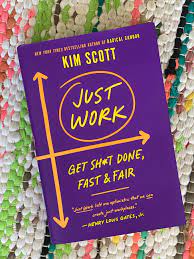What gets in the way of Just Work?
Kim says that three things get in the way of just work: bias, prejudice, and bullying. We often conflate these three terms, but there are slight differences between them that require a unique response to each problem. She began with the following definitions:
Bias is often unintentional and can be defined as “not really meaning it”.
Prejudice is “meaning it” because of a consciously held belief.
Bullying is simply being mean.
Bias can show up in something as subtle as who sits where in a meeting, or who is expected to answer questions. This type of bias can be met with an “I” statement such as, “I think we should switch seats.” This simple statement holds up a mirror to unconscious behavior and invites other people in the room to notice their bias.
Prejudice, on the other hand, is more effectively met with an “it” statement. Kim gave an example of a hiring meeting in which a qualified candidate was discounted because of their natural hair. In a scenario like this, an “it” statement can appeal to the law, a HR policy, or simply common sense: “It is illegal to not hire someone because of their hair.”
Finally, bullying can be challenged with a “you” statement such as, “you can’t talk to me like that,” or, “what’s going on for you here?”. With a “you” statement, you’re pushing the other person away and no longer receiving what they’re sending to you.
What can leaders do to respond?
In addition to how we frame our statements, there are a range of actions that leaders can take to tackle bias, prejudice, and bullying in the workplace.
“We’re conditioned to ignore bias. But when we ignore bias when we notice it, we’re actually reinforcing it,” says Kim. As leaders, it’s important to create a bias disruptor system that involves:
- A shared vocabulary so your team can disrupt bias in the moment. This can also be a visual cue, like a purple flag.
- A shared norm that acknowledges the presence of bias and encourages team members to respond appropriately when their bias is pointed out.
- A shared commitment to embrace the discomfort in this process and build stamina for these conversations.
In the case of prejudice, Kim says you need a code of conduct that sets a clear line for one person’s freedom to believe anything they want, but not impose their beliefs on others. Write this code down and stress test it with your team.
Finally, to effectively respond to bullying, you have to create consequences. This should include:
- Conversational consequences that shut down bullying in a meeting and give everyone a voice.
- Compensation consequences that are baked into your performance review and bonus system.
- Career consequences that prevent the promotion of “brilliant jerks” who damage your team culture.
If someone shows bias, prejudice, or bullying, how long should you give them to fix it?
“If someone is showing bias, bullying, or prejudice, you want to make sure that you give them feedback, especially in the case of bias,” says Kim. “One of the things that I learned as I was writing Just Work is that we often have these biases that are like deeply ingrained habits, and it takes a little while to break habits.”
“We want to be patient with ourselves as we’re fixing bias, but we want to be persistent. As long as you feel like the person is making a good faith effort to change… you want to give people a little bit of time, especially with bias. But if they seem not to care or not to be trying, then you need consequences.”
“The bullies took over my workplace, and as team leader, I finally gave up and quit. What other ideas could I have explored to manage the bullies for my team?”
In response to this question from an audience member at Elevate, Kim recommends that we build solidarity.
“Very often, one can feel gas lit in the presence of bullies because you can’t imagine that other people aren’t noticing. And yet, if you don’t build solidarity with others, they aren’t as likely to come to you to say, ‘that was really messed up.’”
“I would recommend that you locate the exit nearest you, but before you quit, give some feedback directly to your manager and to the people who are bullying. Your manager may not be aware of it… It may get fixed.”
How can we address these challenges in a remote environment?
“There’s a lot of really interesting research that shows when we’re working remotely or in a hybrid environment, we actually get more bias, prejudice, and bullying, not less,” says Kim. “When you’re faced with someone right in front of you, you’re more likely to have context, you’re less likely to be biased. If someone is a tiny square on your computer screen, you’re more likely to give in to your biases, prejudice, and bullying. Having props like the purple flag that you can wave in a meeting is really helpful.”








